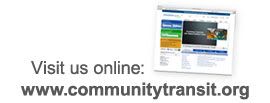
We are now several days into the new year and more details are available about the upcoming
Feb. 20 service change. This is one of the largest service changes in our agency’s history—every route will be affected, although the commuter service to the University District will see only minor schedule changes.
In all, nine routes are being eliminated, 20 routes have changes to their routing and 29 routes will have fewer trips scheduled. There also will be two new routes, one in south county along 196th between Edmonds and Alderwood, and one in north county taking over the eastern portion of Route 240 between Smokey Point and Arlington.
The information now
online is the same information that is in the Guide to Service Change that is going on buses this week. That booklet provides comprehensive information about the routing changes, trip reductions or frequency reductions, and tips for connections for each route. There are also
maps for each route that has routing changes, and
area maps to show how the service will connect in various geographic areas.
What the Guide to Service Change does not have are the specific schedules or bus stop lists for each route. Those will be available online soon, and the Bus Plus schedule books will be on buses at the beginning of February.
Here is an example of what information is in the Guide and
online now:
Route 113: Mukilteo–Ash Way Park & RideRouting Changes -
Map (shown above):
• Revised route ends at Ash Way Park & Ride instead of Lynnwood Transit Center.
• No service south of 164th Street.
Weekday Schedule: Daytime frequency reduced from every 20 minutes to every 30 minutes.
Saturday Service: Frequency reduced from every 30 minutes to every hour.
Connecting Routes: Swift, Routes 101, 112, 115, 116, 119, 201, 202, 413, 415, 417, 810, 860, 880, 885, 511, 532, Everett Transit, Sounder, Washington State Ferries.
Route 113 Rider Tips:• Routes 112 and 113 will connect at Ash Way Park & Ride instead of Lynnwood.
• For service to Alderwood mall or Lynnwood Transit Center, passengers can transfer at 164th Street & 35th Ave. or Ash Way Park & Ride to Routes 115, 116, 201 or 202, all of which have frequent service.
The map shows the new routing, along with what section has been deleted. The rider tips explain that riders wanting to get to Alderwood, Lynnwood Transit Center or the Lynnwood Civic Center can transfer to specific buses to get there.
What riders will discover as they begin to use the newly designed service is that Route 113 now connects to the Ash Way Park & Ride, which has connections all over the county and to Seattle so there are new opportunities. It will take some getting used to, but our planners, faced with the financial reality of cutting 20 percent of our service, redesigned many routes to shorten trips, connect to other service and open up new opportunities.
Because some riders will need to transfer when they didn’t need to before, it is even more important for people to get an
ORCA card if they don’t have one. With ORCA, your fare is transferred to any other trip you take in the next two hours.
In the coming days, and for the next two months, we’ll have more information here and on the website about the Feb. 20 service change.
 The survey takes about 3-4 minutes to complete. Surveyors will be on local buses (100s and 200s and Swift) Tuesday through Saturday handing out and collecting the surveys. These surveyors are temporary workers and will be wearing appropriate ID.
The survey takes about 3-4 minutes to complete. Surveyors will be on local buses (100s and 200s and Swift) Tuesday through Saturday handing out and collecting the surveys. These surveyors are temporary workers and will be wearing appropriate ID.











